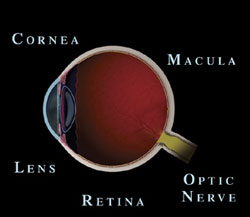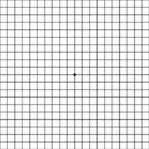Macular degeneration is a disease of the macula, an area of the retina at the back of the eye that is responsible for fine detail vision. Vision loss usually occurs gradually and typically affects both eyes at different rates. Even with a loss of central vision, however, color vision and peripheral vision may remain clear.

Symptoms of macular degeneration:
- Early macular degeneration may cause little, if any noticeable change in vision
- Difficulty reading without extra light and magnification
- Seeing objects as distorted or blurred, or abnormal in shape, size or color
- The perception that objects “jump” when you try to look right at them
- Difficulty seeing to read or drive
- Inability to see details
- Blind spot in center of vision

There are two forms of age-related macular degeneration, wet and dry.
Wet macular degeneration
Wet macular degeneration occurs when abnormal or leaking blood vessels grow underneath the retina in the area of the macula. These changes can lead to distorted or blurred vision and, in some cases, a rapid and severe loss of straight-ahead vision.

Dry macular degeneration
The vast majority of cases of macular degeneration are the dry type, in which there is thinning or deterioration of the tissues of the macula or the formation of abnormal yellow deposits called drusen. Progression of dry macular degeneration occurs very slowly and does not always affect both eyes equally.
Causes of or contributing factors to macular degeneration:
The root causes of macular degeneration are still unknown. Women are at a slightly higher risk than men. Caucasians are more likely to develop macular degeneration than African Americans.
- Age: Macular degeneration is the leading cause of decreased vision in people over 65 years of age.
- Heredity: Macular degeneration appears to be hereditary in some families but not in others
- Long-term sun exposure
- Smoking
- High blood pressure
- High cholesterol
- Hypertension
- Nutritional deficiencies
- Diabetes
- Head injury
- Infection
Diagnosing macular degeneration:
Your eye doctor can identify changes of the macula by looking into your eyes with various instruments. A chart known as an Amsler Grid can be used to pick up subtle changes in vision.
Angiography is the most widely used macular degeneration diagnostic test.

During the test, a harmless orange-red dye called Fluorescein will be injected into a vein in the arm. The dye travels through the body to the blood vessels in the retina.
A special camera takes multiple photographs. The pictures are then analyzed to identify damage to the lining of the retina or atypical new blood vessels. The formation of new blood vessels from blood vessels in and under the macula is often the first physical sign that macular degeneration may develop.
Optical Coherence Tomography (OCT) uses light waves to create a contour map of the retina and can show areas of thickening or fluid accumulation.
Treatment for macular degeneration:
In the early stages of macular degeneration, regular eye check-ups, attention to diet, in-home monitoring of vision and possibly nutritional supplements may be all that is recommended.
Diet and nutritional supplements
There has been active research on the use of vitamins and nutritional supplements called antioxidants to try to prevent or slow macular degeneration. Antioxidants are thought to protect against the damaging effects of oxygen-charged molecules called free radicals. A potentially important group of antioxidants are called carotenoids. These are the pigments that give fruits and vegetables their color. Two carotenoids that occur naturally in the macula are lutein and zeaxanthin. Some research studies suggest that people who have diets high in lutein and zeaxanthin may have a lower risk of developing macular degeneration. Kale, raw spinach, and collard greens are vegetables with the highest amount of lutein and zeaxanthin. You can also buy nutritional supplements that are high in these and other antioxidants.
Low Vision Aids
Unfortunately, the vast majority of cases of wet macular degeneration and virtually all cases of dry macular degeneration are not treatable. In these cases, low vision aids may help make it easier to live with the decreased vision of macular degeneration. Low vision aids range from hand-held magnifying glasses to sophisticated systems that use video cameras to enlarge a printed page. Lifestyle aids such as large print books, tape-recorded books or magazines, large print playing cards, talking clocks and scales, and many other devices are available.
Laser Treatments
In rare cases of wet macular degeneration, laser treatment may be recommended. This involves the use of painless laser light to destroy abnormal, leaking blood vessels under the retina. This form of treatment is only possible when the abnormal blood vessels are far enough away from the macula that it will not damage it. Only rare cases of wet macular degeneration meet these criteria. When laser treatment is possible, it may slow or stop the progression of the disease but is generally not expected to bring back any vision that has already been lost.
A relatively new form of treatment for some cases of wet macular degeneration is called photodynamic therapy or PDT. In those cases where PDT is appropriate, slowing of the loss of vision and sometimes, even improvement in vision is possible.
